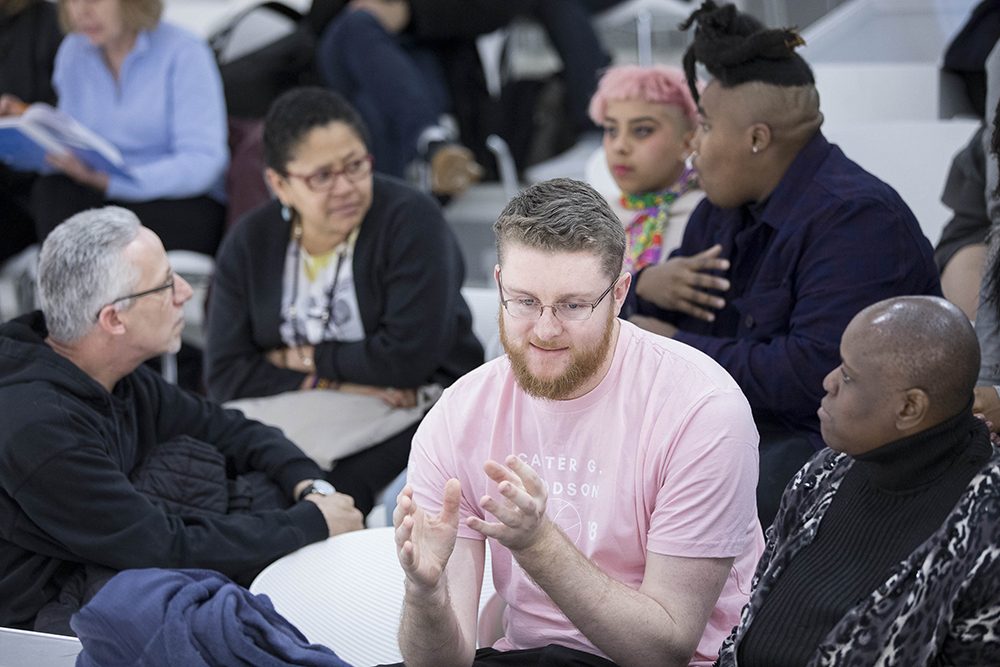Ashley Cabrera, Special Projects Manager for People Operations

In 2024, Mass Cultural Council launched a d/Deaf & Disability Equity Plan (FY25-28) outlining some of the internal and external steps we will take to support and encourage an accessible and inclusive cultural sector in the Commonwealth. As part of the plan, the Agency has committed to building educational resources for accessible and inclusive job postings.
Creating job descriptions that attract people with disabilities is vital for fostering a truly diverse and inclusive workplace. By thoughtfully choosing the language, requirements, and overall presentation of your job postings, organizations can appeal to a broader pool of qualified candidates. This approach demonstrates your commitment to fairness and inclusion. Here are some tips to increase the inclusivity and accessibility of your job postings:
Highlight Your Organization’s Inclusive Culture
- Embrace Diverse Backgrounds: Explicitly encourage applications from individuals with a variety of backgrounds, recognizing that each candidate brings unique skills and experiences.
- Showcase Your Commitment: Highlight your organization’s commitment to diversity and inclusion, including any diversity initiatives, employee resource groups, or inclusive policies.
- Inclusive Employee Benefits: Highlight inclusive benefits such as flexible working hours, hybrid work options, parental leave, and mental health support.
Specify Job Requirements Carefully
- Emphasize Skills and Abilities: Focus on the skills and abilities needed for the job rather than specific credentials or degrees.
- Essential Functions: Clearly describe the essential functions of the job, which must be performed with or without a reasonable accommodation.
- Physical Demands: Specify the physical requirements of the job accurately. This could include lifting, standing, sitting, or other physical activities. Ensure that these demands are truly necessary for the role.
- Cognitive Demands: Include any cognitive requirements such as decision-making, problem-solving, and concentration. Be clear about the mental tasks involved in the job.
- Communication Demands: Outline the communication skills required, whether verbal, written, or both. Highlight the need for clear and effective communication in the job role.
- Sensory Demands: If the job requires specific sensory abilities (e.g., vision, hearing), state these clearly. Ensure that these requirements are essential and not unnecessarily restrictive.
Use Inclusive Language
- Active Voice: Active voice is typically clearer and easier to understand than passive voice. For individuals with cognitive disabilities or those who benefit from straightforward language, this can make job descriptions more accessible. Additionally, an active voice directly addresses the candidate, making the description feel more personal and empowering. This can encourage people with disabilities to apply.
- Clear and Concise Language: Clear and concise language helps ensure that individuals can easily comprehend the job requirements. This reduces barriers to understanding and makes the application process more accessible. Avoid using acronyms or jargon that might be unfamiliar to candidates.
- Focus on Skills: Clear language helps to emphasize the skills and abilities required for the job rather than unnecessary details or complex terminology. This allows candidates to better align their experiences and qualifications with the job requirements.
- Neutral and Accessible Language: When in doubt, assume the candidate doesn’t know anything about your organization. Avoid using organizationally specific terms that could make some candidates feel unqualified for a position they are otherwise qualified for.
- Gender-Neutral Language: Use gender-neutral terms such as “they/them” instead of “he/she” and avoid gender-specific job titles.
- Avoid Idioms and Colloquialisms: Steer clear of idioms, slang, or colloquial expressions that might be unfamiliar to non-native speakers or individuals from different cultural backgrounds.
Provide Accommodations Information
- Mention Availability of Accommodations: Clearly state your organization’s commitment to providing accommodations and provide contact information for accommodation requests.
- Types of Accommodations: Offer examples of accommodations available, such as assistive technologies, sign language interpreters, alternative formats for application materials, and flexible interview scheduling.
Formatting
- Consistent Formatting: Use a consistent and logical structure, breaking information into bullet points or short paragraphs. Consistent formatting helps candidates with disabilities, such as dyslexia or ADHD, process information more effectively.
- Readable Fonts and Layouts: Choose easy-to-read fonts and layouts with sufficient contrast between text and background. These considerations help individuals with visual impairments or reading difficulties access the information comfortably.
By incorporating these strategies into your job postings, organizations can create a more inclusive and accessible application process, ultimately attracting a diverse and talented pool of candidates.
Mass Cultural Council strives to follow these best practices for access and inclusivity in its own team recruitment efforts.
